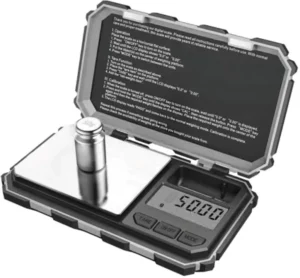
Fiziom Professional Digital Scale User Manual
Instructions
Thank you for purchasing our scale. Normal care and proper treatment will provide for years of reliable service. Please read all operating instructions carefully before use. It may be necessary to calibrate the scale before the first use.
Standard Features Include:
- Unique hinged cover design protects the scale
- Rugged plastic construction with stainless steel weighing pan
- High contrast LCD
- Weighs in g,oz,dwt,gn,ct,ort
- Low battery indicator
- Energy-saving auto shut-off feature.
SPECIFICATIONS
| Capacity | 200g |
| Readability | 0.01g |
| Units | g,oz,dwt,gn,ct,ort |
| Calibration | External Calibration |
| Tare Range | Full Capacity |
| Auto off(default) | 60/120/180 seconds |
| Operating Temperature Range | 10-30 C |
| Display | LCD |
| Power Requirements | 2xAAA Batteries(included) |
LCD DISPLAY
- Current Weight
- Weight unit
- Low battery
- Negative weight value
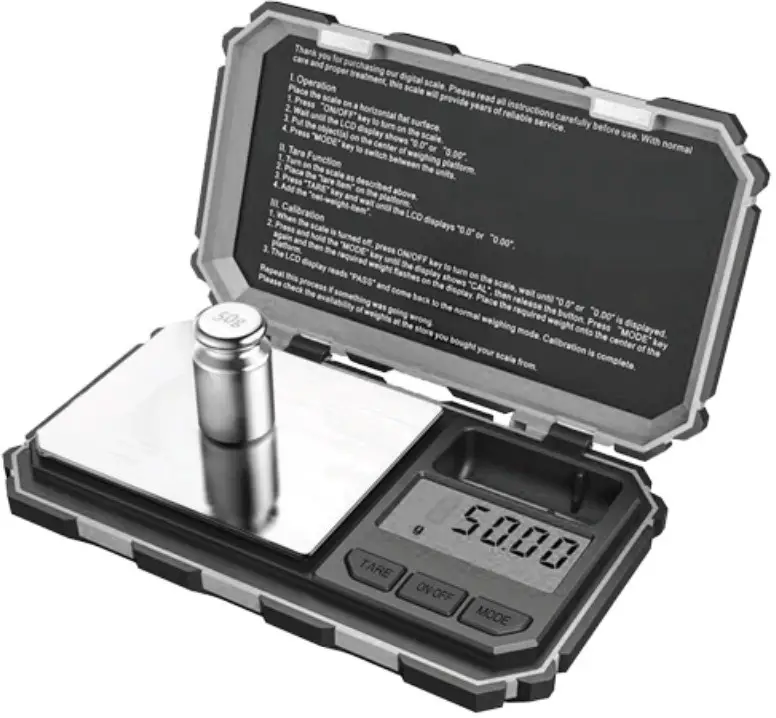
Operation
- Open the battery compartment cover located on the backside of the scale.
- Insert 2xAAA batteries into the battery compartment.(note: please follow the polarity +/- diagram in the battery compartment) The LCD will be on as below.

- Replace the battery cover and place the scale on a horizontal flat surface, then wait until “0.000” is displayed.
- Press the MODE key to switch between weight units

- Put the object or samp e on the weighing platform and wait until the reading is stable.
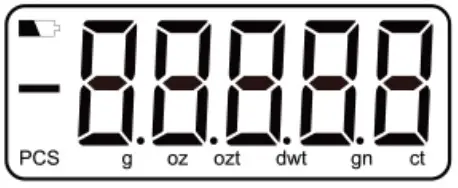
TARE WEIGHING
- Press the ON/OFF button to turn on the scale.
- Place the “tare item”(weighing container) on the weighing platform.
- Press TARE and wait until “0.000”is displayed.
- Add the “sample” into or on the weighing container.
Calibration
- place the scale on a leveled surface & power it on.
- Press and hold the “MODE” key until the display reads “CAL”, then release the key.
- Press “MODE” key again and the display will show the required calibration weight.
- place the weight on the center of the platform . The LCD display will read “pass” and then return to normal weighing mode
- Remove the weight and turn off the scale.
Auto off(default)
If there is not any operation and the weight is steady in weighing mode, the scale will turn off automatically after about 180 seconds(default).
How to change the auto-off time
- In weighing mode, press and hold the TARE key until the display reads the present auto-off time.
- Press the MODE key to switch between 0, 60, 120, 180 seconds.(0 means to turn off the auto shut-off function.)
- Press the ON/OFF key to confirm your choice and complete the setup, the scale is turned off at the same time.
Indication Message
Low battery indication: ”  “, “Lo” or “88888” Please replace the new batteries.
“, “Lo” or “88888” Please replace the new batteries.
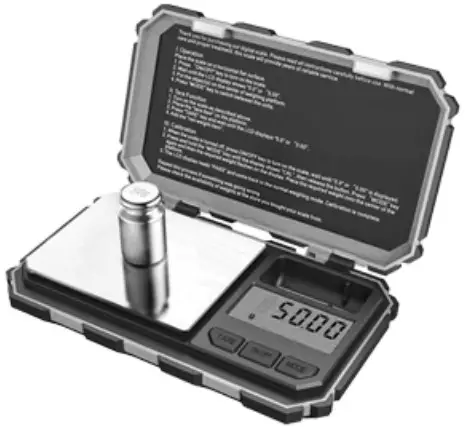
“OUT2”: Please recalibrate the scale per the instructions above.
Overload indication: “O-Ld” Please remove the object from he weighing tray immediately.

“LLLLL”: The internal components have been damaged.(i.e. it was shocked, dropped, or excessively overloaded). Try to recalibrate the scale. If the scale was not damaged too much, recalibration may fix the problem.
Unstable Indication: “UNST” Please use the scale in a more stable (i.e. flat) position.
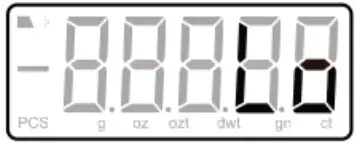
TROUBLESHOOTING
The primary reason for inaccuracy or malfunction of the scale is due to low batteries or incorrect installation of batteries, incorrect or infrequent calibration, overloading the scale, or operating the scale on an unstable surface. Please keep in mind to maintain and operate your scale properly. The scale is a precision instrument and must be handled with the utmost care and caution.
PROPER OPERATION AND ENVIRONMENT
- Avoid any exposure to extreme heat or cold, your scale works better when operated at normal room temperature. It is recommended to allow the scale to acclimate to normal room temperature for at least one hour before use.
- Allow your scale sufficient time to warm up. Usually 30-60 seconds to give the internal components a chance to stabilize before calibration.
- Keep your scale in a clean environment. Dust, dirt, moisture, vibration, air currents, and a close distance to other electronic equipment can cause an adverse effect on the reliability and accuracy of your scale.
- Handle your scale with care. Gently apply all items or samples to be weighed onto the weighing surface. Although this scale is designed to be quite durable, try to avoid rough treatment as this may permanently damage the internal components.
- Avoid shaking, dropping, or otherwise shocking the scale. This is a precision instrument and must be handled with extreme care.
- Only operate the scale on a stable, vibration free surface.